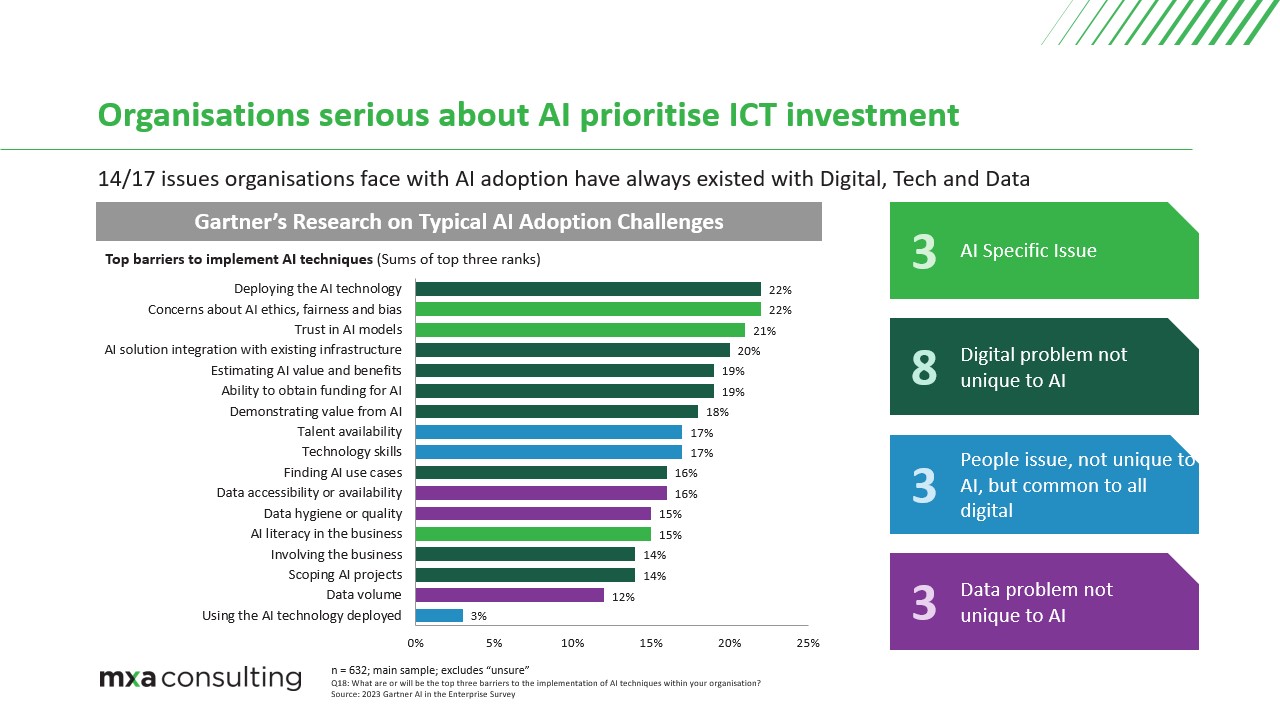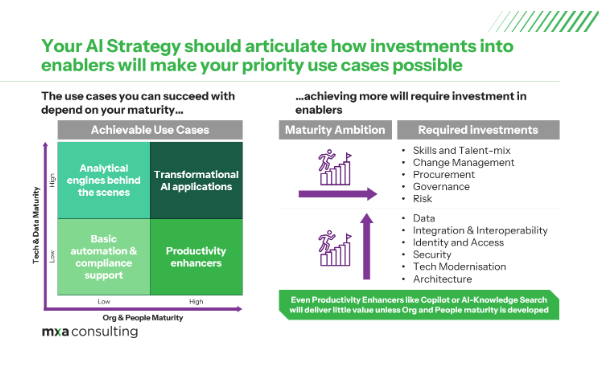2. Integration
Integration defines how systems, data, and services connect to deliver outcomes. When integration is ad hoc or point-to-point, change becomes slow, brittle, and expensive. When it is structured and governed, the organisation gains visibility, control, and speed; the ability to replace, scale, or add solutions without undue expense. Many organisations still operate with undocumented legacy connections and unmonitored data flows. This makes troubleshooting near-impossible and creates security and compliance risks. A modern approach replaces this hidden complexity with structured integration that is observable, maintainable, and adaptable. Executives should focus on three actions:
1. Implement a structured integration platform.
Move away from custom scripts and direct connections to an Integration Platform as a Service (iPaaS) or equivalent middleware. A centralised integration layer provides monitoring, access control, and reusable connectors. It allows teams to understand the environment, trace issues, and manage changes predictably.
2. Create clear ownership and standards.
Define integration as a service with accountable owners, documented APIs, and agreed data contracts. All new systems should integrate through approved channels using common authentication, logging, and error-handling patterns.
3. Design for change.
Ensure every connection can be swapped or extended without breaking others. Structured versioned APIs, and event-driven designs (not necessarily everywhere) make it possible to add or retire systems quickly when better solutions emerge.
3. Identity and Access
Identity and access management (IAM) determines who can do what across your digital environment. Whilst it is tempting to think of IAM as a technology cost to be left for the nerds, it is the lynch pin of productivity and security, so needs attention and investment. Modern AI platforms mix both cloud-based and on-prem designs, and integrate across multiple services, so clarity about identities is both foundational and challenging to get right. If you haven’t invested in this topic for a while, you can expect your current setup to have challenges and security vulnerabilities in the new era. Executives should focus on three actions:
1. Adopt a unified identity platform.
Move away from separate identity stores maintained by each system. Implement a single enterprise directory or identity provider (such as Azure AD or Okta) with centralised authentication and role management. This simplifies onboarding, offboarding, and compliance reporting, and it reduces risk from orphaned or duplicated accounts.
2. Implement strong, adaptive access controls.
Apply least-privilege and Zero Trust principles: always verify, never assume. Access should be conditional on context (e.g., device, network, location, and role) and reviewed regularly. Automation should handle provisioning and revocation, with approvals tied to business capability owners.
3. Integrate IAM into every project.
Treat identity as a shared service, not a technical detail to be addressed late in delivery. All new systems and AI platforms should integrate with enterprise identity and authorisation services by default, with no exceptions.
4. Data
Data is a big topic, and as the foundation of AI, requires a more detailed discussion than we can fit here. We have seen some remarkable business transformations that occur when an organisation gets its data right; because decisions and operations become based on fact, not opinion. In any case, it must be acknowledged that weak, fragmented, or poor-quality data will undermine every AI initiative, no matter how advanced the vendor promises the technology to be. Gartner research indicates that 57% of organisations estimate their data isn’t AI-ready (and we expect a large percentage estimate it is ready but are incorrect due to unknown unknowns). Strong data capability, by contrast, enables accuracy, trust, and speed.
Executives should focus on five actions:
1. Set a clear data strategy.
Define how data supports business and AI goals. Prioritise what data matters most, where it will come from, and how it will be used. A strong data strategy articulates outcomes, governance principles, and investment priorities, not just technology choices.
2. Strengthen data architecture.
Within the broader enterprise architecture, data architecture deserves focused attention. Define core data domains, master data entities, lineage, and interfaces. Ensure each data asset has a clear owner and service-level expectations. Design for scalability, observability, and compliance.
3. Invest in data infrastructure and technology.
There is a large array of technologies out there for data, so organisations must be mindful of spend. However, there are some minimums to be a highly mature. Organisations should build a modern data, typically including:
- Master Data Management (MDM) to maintain consistency across systems.
- Data lakehouses or equivalent to unify structured and unstructured data.
- Metadata catalogues for discoverability.
- Data pipelines and workflow orchestration tools for automation and quality assurance.
4. Define a fit-for-purpose operating model.
Choose how data will be managed and governed across the organisation.
- A centralised model offers control and standardisation.
- A decentralised model aligns ownership to business domains and speeds local delivery.
- Hybrid models (such as data mesh or fabric) combine domain ownership with shared infrastructure and standards.
The key is clarity: who owns what, how they collaborate, and how decisions are made.
5. Embed governance, quality, and stewardship.
Establish data policies, stewardship roles, and consistent controls for access, privacy, and retention. Implement quality metrics, lineage tracking, and feedback loops to fix issues at the source. Ensure governance is about accountability and mindful trade-offs, not bureaucracy.
Improving your Organisational and People Maturity
With such a large topic, we’ll focus our advice on three key priorities:
1. Put in place the right leadership who have the capability to move your organisation at the pace you want to, taking on board the right level of risk. Generally, the more change you want to drive, the more your technology leadership need to have a development background, not an operational one.
2. Be honest about the goal. Organisations are either seeking to reduce cost via headcount or increase productivity and the focus on high-value work. Being honest about your intentions is important to get the needed participation from your people in the transformation and is the right thing to do.
3. Invest in the skills of your people so that they are willing and able to work in new ways both now and into the future. Unlike Technology investments, there are rate-limits on how fast people can change, so early and consistent investment is required; organisations must not put this off.
1. Put the right leadership in place
Transformation requires leaders who understand technology as a professional discipline with nuances and its own culture, not merely a cost centre. When it comes to leadership, it is important to understand that status and respect in technology culture is inferred from the technical capability of the individual, not their paygrade or job title. In other words, high-capability technologists in your organisation will respect your leader in proportion to their technical capability. For this reason, the choice of a high capability leader matters hugely if you wish to recruit and retain top AI talent.
If the goal is transformational change, appoint leaders with backgrounds in technology development: those who have a track-record for balancing innovation with risk, and who see failure as part of learning. If the goal is continuous improvement, leaders from operations are often more suitable. Their track record is for reliability and quality, and they will bring the discipline needed to drive incremental gains without eroding trust from business areas or customers. Note that leaders whose background is from finance are rarely suited to lead technology functions in periods of change. These people feel their primary purpose is to save money and/or obtain more certainty around cost. Consequently, they tend to cut things critical to an innovative organisation, ignore things that they don’t understand or are difficult to put numbers to, and shy away from fast-changing technologies and powerful strategic partners.
2. Be honest about the goal
As responsible advisors, we feel an obligation to push organisations to have honest conversation about their intentions for benefits with AI. Many organisations, especially in the private sector, are in-fact seeking cost savings from headcount reduction, but they spread a narrative about focusing on higher-value work. The more forward-thinking private sector organisations are aiming for a team shift; a reduction in low value roles, and more investment into future-fit roles, i.e., different people, generally not a reskill. On the other hand, most of the public sector we have engaged with are seeking productivity improvements; the same people being able to output more high-value work for a given period of time. This is a great message, but these organisations often are unable to measure productivity, so will see increased scepticism when AI solutions enter their “trough of disillusionment”. It also assumes those people are willing to move to more challenging work.
Regardless of your direction, driving your AI transformation will require extracting the deep know-how of your people and both redesigning processes and encoding the know-how in AI agents. This requires long-term, deep participation, likely from exactly the people who ill be impacted by redundancies or job role changes. If you’re not honest about whether you are seeking to reduce headcount or shift the focus to high-value work, people will either assume the worst, or figure it out, and stifle your plans. Being honest is also the right thing to do (and we are of the opinion that is enough of a justification). Whilst there are risks in transparency, we believe the courageous thing is to try and work through them.
3. Invest in the skills of your people
The shift to AI native organisations will require a large shift in the skills and mindsets of your people. Australian organisations in particular have underinvested in skilling relative to their OECD peers, so changing the level of investment and capturing benefits will be particularly difficult in our context. The key transition that will occur in the next few years is the shift to almost everyone being a manager and leader, even new graduates and individual contributors. This is because even junior roles will be managing a collection of AI agents to do tasks for them. To be successful, executives should focus on building 8 skills in their organisation:
1. Critical Thinking Problem Solving
2. Structured Communication
3. Leadership and Social Influence
4. Curiosity and lifelong learning
5. Technology Literacy
6. AI and Big Data
7. Resilience, Flexibility and Agility
If cost-savings is indeed the agenda, we advise to invest in reskilling programs; the ROI is worthwhile (particularly taking into account brand value), it gives people an incentive to help drive the change (which you will need), and it is the “right” thing to do by employees who have supported your organisation for years. If AI within your organisation is about focusing on higher value work, then the priority should be to invest in upskilling. Here, it’s important to remember that not everyone will be able or willing to give up on their easy, routine work. In this context, strong change management and potentially talent cycling will be needed.







